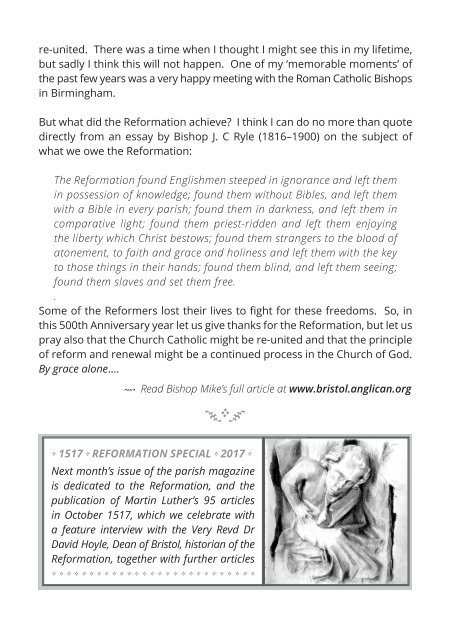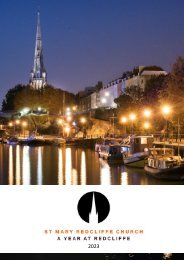St Mary Redcliffe Church Parish Magazine - September 2017
You also want an ePaper? Increase the reach of your titles
YUMPU automatically turns print PDFs into web optimized ePapers that Google loves.
e-united. There was a time when I thought I might see this in my lifetime,<br />
but sadly I think this will not happen. One of my ‘memorable moments’ of<br />
the past few years was a very happy meeting with the Roman Catholic Bishops<br />
in Birmingham.<br />
But what did the Reformation achieve? I think I can do no more than quote<br />
directly from an essay by Bishop J. C Ryle (1816–1900) on the subject of<br />
what we owe the Reformation:<br />
The Reformation found Englishmen steeped in ignorance and left them<br />
in possession of knowledge; found them without Bibles, and left them<br />
with a Bible in every parish; found them in darkness, and left them in<br />
comparative light; found them priest-ridden and left them enjoying<br />
the liberty which Christ bestows; found them strangers to the blood of<br />
atonement, to faith and grace and holiness and left them with the key<br />
to those things in their hands; found them blind, and left them seeing;<br />
found them slaves and set them free.<br />
.<br />
Some of the Reformers lost their lives to fight for these freedoms. So, in<br />
this 500th Anniversary year let us give thanks for the Reformation, but let us<br />
pray also that the <strong>Church</strong> Catholic might be re-united and that the principle<br />
of reform and renewal might be a continued process in the <strong>Church</strong> of God.<br />
By grace alone….<br />
Read Bishop Mike’s full article at www.bristol.anglican.org<br />
<br />
1517 REFORMATION SPECIAL <strong>2017</strong> <br />
Next month’s issue of the parish magazine<br />
is dedicated to the Reformation, and the<br />
publication of Martin Luther’s 95 articles<br />
in October 1517, which we celebrate with<br />
a feature interview with the Very Revd Dr<br />
David Hoyle, Dean of Bristol, historian of the<br />
Reformation, together with further articles<br />
<br />
<br />
church matters from the pcc<br />
REPORT ON PCC MEETINGS 3rd & 31st JULY <strong>2017</strong> AT THE MERCURE HOLLAND<br />
HOUSE HOTEL — CHAIR: REVD DAN TYNDALL<br />
PCC MEETING 3rd JULY: THE HOGARTH ALTARPIECE<br />
The PCC met to vote on the motion: “The PCC resolves<br />
that the Hogarth altarpiece is of such significance to our<br />
history and heritage and to the stories we wish to tell<br />
through our facilities development project that we continue<br />
to investigate the possibility of it being part of that project.”<br />
The meeting was convened to decide whether to continue including the<br />
Altarpiece in the church’s Development Project since the decision affects<br />
all future plans. Present were the Development Project Board (DPB) Chair,<br />
and three-quarters of the PCC membership. An appraisal was given of the<br />
advisory (brainstorming) sessions that had been arranged to inform the<br />
PCC about the potential relevance of the Altarpiece to SMR’s mission, and<br />
the feasibility of adopting it in its plans. These were: i) the Hogarth Options<br />
Appraisal Workshop (HOAW) in May convened for those with a professional<br />
interest in the Altarpiece and/or the Development Project, and; ii) the June<br />
DPB meeting convened to formulate a motion for the PCC to vote on, at<br />
which the formal HOAW findings were taken into account. Discussion ended<br />
in a last-minute amendment to the above motion, proposed and adopted in<br />
its stead in a 2–1 majority vote [figures here and below to be confirmed].<br />
The substitute motion “The PCC resolves to continue to explore the possibility<br />
of the Hogarth altarpiece being part of our facilities development project” was<br />
voted on, and carried with a 2–1 majority. The PCC did not rule out including<br />
the Altarpiece in its future Development plans, but the amendment and<br />
majority vote meant that as a body the Council feels that it does not at<br />
present have sufficient data, knowledge or understanding and, therefore,<br />
confidence to be able to judge the value of the work to the church’s mission.<br />
Discussion had ranged between considering the elements and histories<br />
of the work itself — art, aesthetic, social, theological, ecclesiastical, Bristol<br />
and parochial — and the practicalities of ‘adopting’ it. Though members<br />
had been asked to concentrate on the work’s attributes (as mentioned) in<br />
from Hogarth’s<br />
self-portrait ca. 1735


















